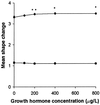Characterization of the priming effect by pituitary canine growth hormone on canine polymorphonuclear neutrophil granulocyte function
- PMID: 10702497
- PMCID: PMC95853
- DOI: 10.1128/CDLI.7.2.226-232.2000
Characterization of the priming effect by pituitary canine growth hormone on canine polymorphonuclear neutrophil granulocyte function
Abstract
In this report, we demonstrate that canine growth hormone (cGH) is capable of priming canine polymorphonuclear neutrophil granulocytes (PMN) in a manner resembling that of human PMN. The cGH influences important functions that are involved in the process of recruitment of PMN, i.e., shape change, chemotaxis, CD11b/CD18 expression, adhesion, and subsequent transendothelial migration. Also, intracellular O(2)(-) production was evaluated. We investigated the priming effect by incubating PMN with purified pituitary cGH at various concentrations (10 to 800 microg/liter). The capacity for shape change was significantly (P < 0.05) enhanced, whereas the chemotactic response under agarose was significantly (P < 0.05) reduced. The chemotactic migration in Boyden chambers (10-microm-thick polycarbonate filter; lower surface count technique) was significantly (P < 0.05) enhanced, presumably due to cGH-induced hyperadhesiveness to the lower surface of the filters. The adhesion in albumin-coated microtiter plates and adherence to canine pulmonary fibroblasts were significantly (P < 0.05) increased, and the increased adhesion resulted in a significant (P < 0.01) increase in transendothelial migration using canine jugular vein endothelial cells. The increase in adhesion was associated with a significant increase in CD11b/CD18 expression. Furthermore, intracellular O(2)(-) production was significantly enhanced in response to both phorbol myristate acetate (P < 0.01) and opsonized zymosan (P < 0.05). In the absence of a PMN-stimulating agent, cGH did not influence the effector functions investigated except for an increased expression of CD11b/CD18.
Figures







Similar articles
-
CD18 integrin-dependent endothelial injury: effects of opsonized zymosan and phorbol ester activation.J Leukoc Biol. 1994 Jan;55(1):58-63. doi: 10.1002/jlb.55.1.58. J Leukoc Biol. 1994. PMID: 7904295
-
Neutrophil adherence to isolated adult canine myocytes. Evidence for a CD18-dependent mechanism.J Clin Invest. 1990 May;85(5):1497-506. doi: 10.1172/JCI114596. J Clin Invest. 1990. PMID: 1970581 Free PMC article.
-
Effect of mechanical deformation of neutrophils on their CD18/ICAM-1-dependent adhesion.J Appl Physiol (1985). 2001 Sep;91(3):1084-90. doi: 10.1152/jappl.2001.91.3.1084. J Appl Physiol (1985). 2001. PMID: 11509502
-
Activation-dependent proteolytic degradation of polymorphonuclear CD11b.Br J Haematol. 2000 Dec;111(3):934-42. Br J Haematol. 2000. PMID: 11122158
-
Hydrogen peroxide and superoxide modulate leukocyte adhesion molecule expression and leukocyte endothelial adhesion.Biochim Biophys Acta. 1996 Feb 29;1310(3):251-9. doi: 10.1016/0167-4889(95)00169-7. Biochim Biophys Acta. 1996. PMID: 8599602
Cited by
-
Intrathymic somatotropic circuitry: consequences upon thymus involution.Front Immunol. 2023 Jun 22;14:1108630. doi: 10.3389/fimmu.2023.1108630. eCollection 2023. Front Immunol. 2023. PMID: 37426675 Free PMC article. Review.
References
-
- Absolon D R. Basic methods for the study of phagocytosis. Methods Enzymol. 1988;132:136–137. - PubMed
-
- Babior B M. Oxidants from phagocytes: agents of defense and destruction. Blood. 1984;64:959–966. - PubMed
-
- Bommakanti R K, Bokoch G M, Tolley J O, Schreiber R E, Siemsen D W, Klotz K N, Jesaitis A J. Reconstitution of a physical complex between the N-formyl chemotactic peptide receptor and G protein. Inhibition by pertussis toxin-catalyzed ADP ribosylation. J Biol Chem. 1992;267:7576–7581. - PubMed
-
- Burns A R, Simon S I, Kukielka G L, Rowen J L, Lu H, Mendoza L H, Brown E S, Entman M L, Smith C W. Chemotactic factors stimulate CD18-dependent canine neutrophil adherence and motility on lung fibroblasts. J Immunol. 1996;156:3389–3401. - PubMed
-
- Butcher E C. Specificity of leukocyte-endothelial interactions and diapedesis: physiologic and therapeutic implications of an active decision process. Res Immunol. 1993;144:695–698. - PubMed
MeSH terms
Substances
LinkOut - more resources
Full Text Sources
Research Materials

